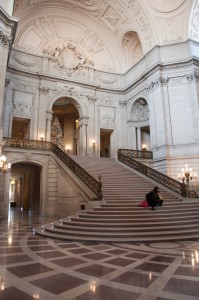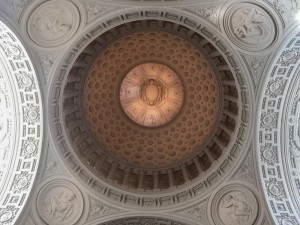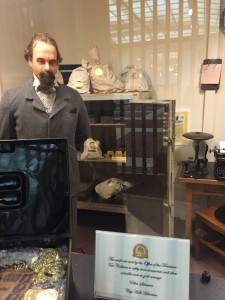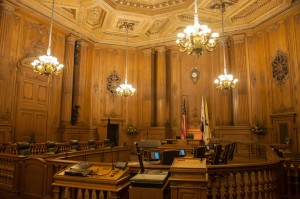San Francisco has long held an important place in the political realm, with its progressive ideals and social activists of all types. City Hall has been the site of historic events from protests to a double assassination to memorial services and marriages.
The current City Hall was built in the aftermath of San Francisco’s Great Earthquake of 1906 as part of the city’s rebirth, and finished in time for the Panama Pacific Exposition of 1915. The city and county seat of government was designed in the Beaux-Arts style, like several other important sites in San Francisco. City Hall was designed by the same architects (Bakewell and Brown) as the War Memorial Opera House down the street, as well as Coit Tower.
City Hall is a display of grand architecture fitting for a grand city. Capped by a rotunda much like the national capitol, San Francisco City Hall actually stands a bit taller than the US Capitol building. The exterior of the building is granite, while inside the walls and floors are covered in marble and limestone.
San Francisco City Hall offers free guided tours throughout the week. For the building’s centennial celebration in 2015, City Hall offered tours on weekends as well.
After waiting outside the building’s locked doors on the steps of City Hall (and becoming part of a proposal video shoot in the meantime), we were eventually greeted by City Hall historian Ellen Schumer. She told us that it was the first time that the building was opened on a Sunday in 12 years.
We passed through metal detectors and gathered under the cupola to admire the sculptural details of the architecture. They don’t make them like this anymore. We were ushered into the South Light Court on the main floor, where there is a museum with glass displays of artifacts from throughout San Francisco history. The rotating exhibits, created by the San Francisco Arts Commission, showcase significant moments in the building’s history. One case held a wooden model of a cross-section of the cupola, showing several levels and many intricate details. Another held several ornate keys to the city, with photos showing city mayors giving them to prominent figures like Steph Curry. A prominent display of wedding memorabilia included photos of Marilyn Monroe and Joe DiMaggio, one of the most famous couples to have married at San Francisco’s City Hall.
The historian explained that City Hall sees an average of 38 weddings per day. Without a microphone, the historian had a difficult time holding the attention of the large tour group. She grew agitated with the many guests who did not heed her directions and wandered away from the group and shouted at them, though most did not seem to understand her.
Off to the side of the large room was a vault, with a sign inside explaining that it had been used by the Office of the Treasurer Tax Collector to store documents and gold coins. Today, the vault is sealed off with iron bars not unlike a prison. Disconcertingly, a man in a suit stands inside, staring out as he guards the moneybags and gold treasure held within. I had to look closely but carefully to be sure that the lifelike mannequin peering coldly out past the bars, like we hadn’t noticed that we’d been transported to Alcatraz circa (1950), wasn’t a real person (he wasn’t). I broke his hypnotizing glare when the historian called us to follow her up the grand staircase.
With a brief stop to admire the Christmas tree, decorated beautifully with thousands of small paper cranes, we entered the Board of Supervisors Chamber, where the legislative board meets to discuss and decide city issues. We filtered inside and took seats at the rows of wooden pews, noticing that the large screens at the front of the room projected our own faces back at us.
Here the historian allowed a volunteer docent to tell us about the room – briefly. He explained that the walls were carved from Manchurian Oak, the ship carved into the ceiling was called the San Carlos, and was the first ship to enter the Bay, and the carpet design featured dahlias, which was a reference to the Mexican alcalde’s gift to Yerba Buena. The historian interrupted to quiz the docent on the lighting fixtures, and when he was stumped by her trivia, she found herself giving the talk, explaining in a way I assume she thought to be polite that the docents were mere volunteers and that she’d been the historian at City Hall for [x] years. She was strangely endearing.
When she finished, she released us to exit the building so she could prepare for the next tour. On our way out, we passed the bronze bust of Harvey Milk and someone asked her about the historic shooting assassination of he and George Moscone that took place in this building. It was one of the most famous and certainly most tragic incidents in the building’s history, and whether she assumed we all knew about it already or was more focused on the building itself, it was surprising that she did not include it in her discussion except to say that the movie about the event, Milk, was filmed there (as well as some others like Foul Play). She also added that a documentary called The People’s Palace was made for the Centennial celebration for KQED provides a comprehensive history of City Hall.
Address
1 Dr. Carlton B. Goodlett Place, San Francisco, CA
(at Civic Center Plaza between Van Ness Avenue and Polk Street)
Hours
Monday through Friday: 8 am to 8 pm
Tours are scheduled at 10 am, 12 pm, and 2 pm, lasting about 45 minutes to hour





